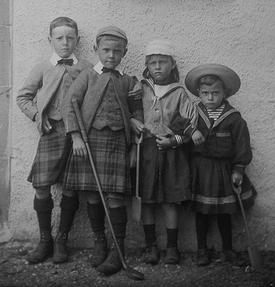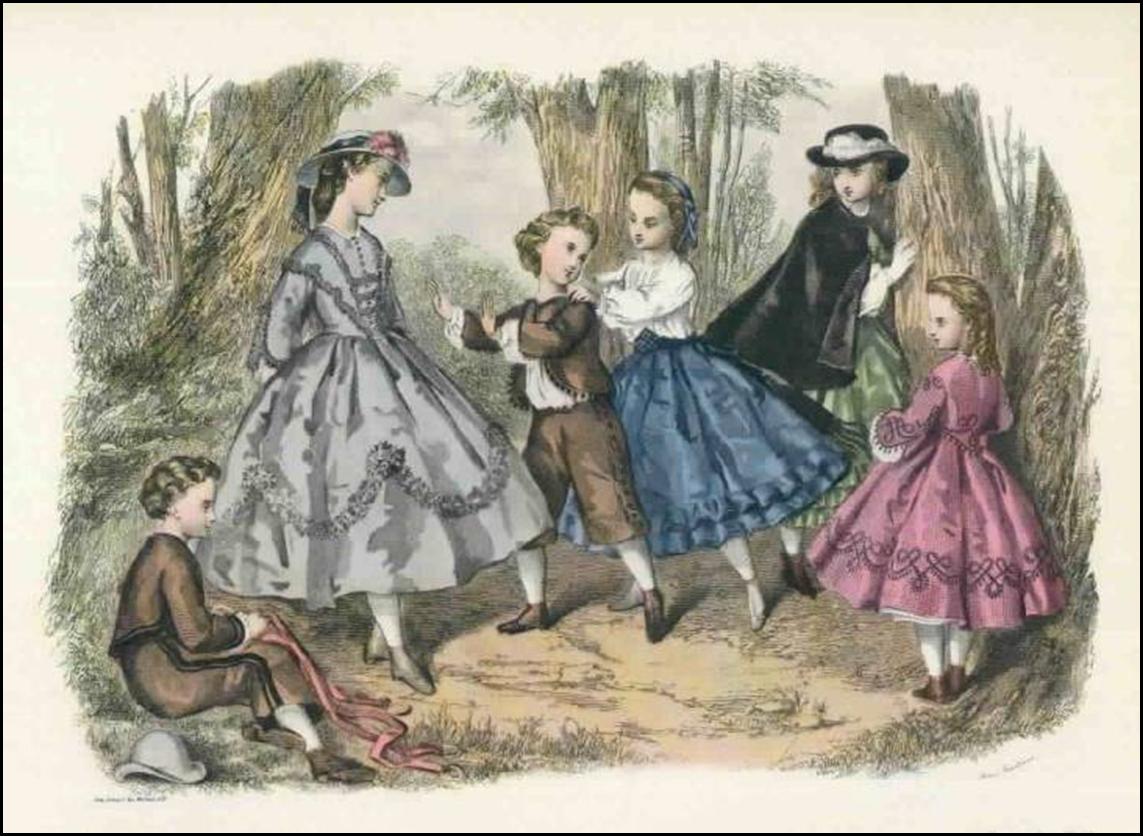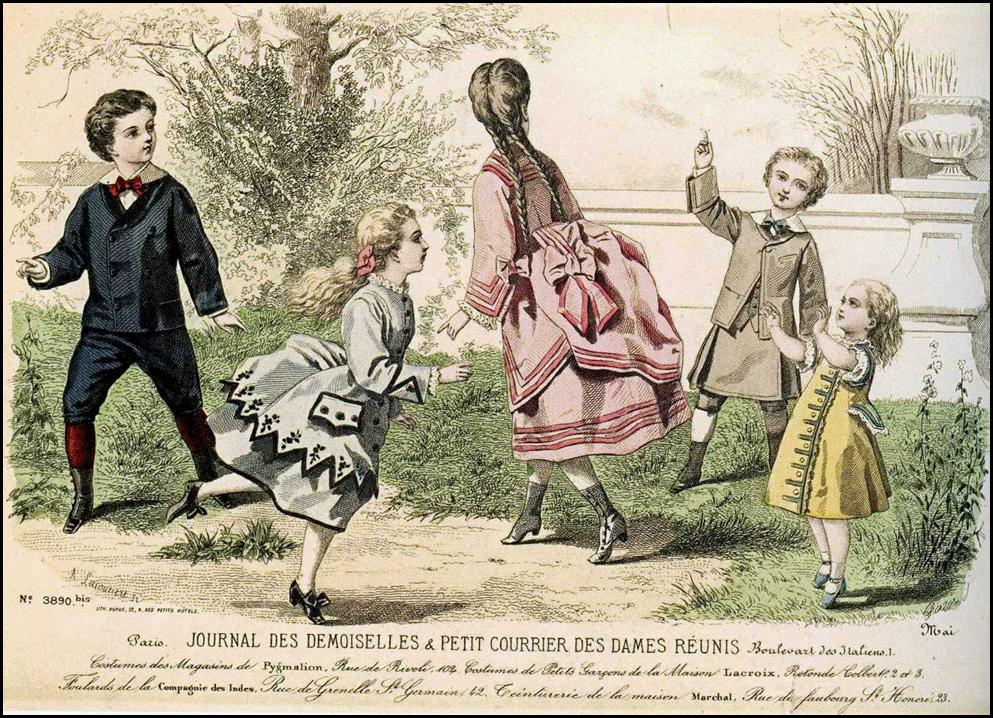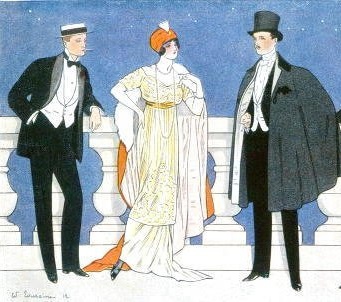19th Century Children

by Lynn Downward, First published for the November/December 2011 issue of Finery
So you want to bring the kids to Dickens Fair this year – in costume! How can you possibly build children’s clothes when you’ve never researched them before and you have no time or money budgeted for it? In preparation for Dickens Fair, here is an overview of children’s clothing for the period of 1845-65. This information will get any child into the fair looking appropriate enough to feel right at home – and different enough to be something novel and cool. I’ll offer tips for one weekend costumes and more if your kids wants to participate for the full run of fair next year.
Children’s fashions have made a stylistic full circle. Children as late as the 17th century wore clothes just like their parents’ with no concession made to childhood.
Special juvenile styles began to appear during the late 18th century, and age-specific clothing was standard during the 19th century and first half of the 20th century. Children have returned to dressing in increasingly adult styles since the 1960s. Now many adults have taken to wearing the casual or faddish styles preferred by children.
All mid-to-late 19th Century toddlers, boys and girls both, wear the same basic clothing: a dress, often with a pinafore over it, white stockings, and leather boots or shoes. The pinafore can be white or any color, solid or small print. Dressing small children in skirts makes it easier to change their diapers. Shoes with low heels are best for every age of child, and shoes were most often black, brown or red (think of Buster Brown shoes for the perfect look). There are hundreds of photographs on the internet to help you find information.

The main differences in portraits of small 19th Century boys and girls is that girls are always shown with a middle part and boys with a side part; you can often only tell if the subject is a boy because of the ‘prop’ he is holding: a toy horse or drum for example. Boys often wore dresses of dark solid colors or plaids.
Many modern daddies don’t want to see their sons in dresses; in this case you can use short trousers with a matching jacket. If you can’t find a short pants outfit second hand, you can find a second-hand trouser suit and rework the jacket to suit the period, depending on your sewing ability. You can easily make the long trousers into knickers by cutting them below the knee and gathering them to a cuff made from the lengthwise part of the cut-off leg. Button the cuff and there you are. Attaching the button with thick elastic or a long thread shank will give your son more movement. Add a newsboy cap and you have a Victorian boy, aged 2-7.
At ages 4-7, clothing for girls is exactly what they wore at 2 and 3: a simple dress with a pinafore over it to keep them clean, with the addition of petticoats or hoops for older girls, as fancy or as plain as desired. At this age, girls’ dresses have a defined waist and the same dropped shoulder line and full skirts as their mothers’. Existing dresses for girls between 2 and 5 years old have skirts as wide as 60-80” at the hem, which explains the need for petticoats.
As the girls get older their dresses get longer until they are 15-16 and have full-length skirts, can put their hair up and are considered young ladies. Girls from 3-14 for a day or one weekend should have a full skirt to mid-calf and white cotton knee socks or stockings and petticoats. Add a white cotton chemise, white cotton drawers and more petticoats for her own comfort if she will be participating. The drawers and petticoats should not show under the dress. In the period, girls seemed to wear a pinafore until they were old enough to refuse, indicating that the pinafore is a little girl’s style.
Victorian clothes for boys are very easy to find on eBay if you look for sailor suits, knickers, or Eton jackets. Zouave jackets were very popular for boys also; they look like waist-length boleros with sleeves. Jackets only have one button for boys. You could even go with a dickey, collar and front, under the jacket and over their favorite tee-shirt. This will work until your son is old enough to wear long pants, about eight years old for our purposes. For one weekend a white shirt, vest and jacket will be all that’s necessary. A colorful cravat and newsboy’s cap will give the finishing touches. Elizabeth Stewart Clark has lots of more detailed information on her website: http://www.thesewingacademy.com/compendium/ including a forum for discussions if you have more in-depth questions.
Children’s period shoes aren’t as difficult to find as it might seem. I often see shoes and boots that will work for Victorian in second-hand stores. Again, in the period the shoes were low heeled, made of leather and laced, buckled or were pulled on. The leather ones with the elastic sides are preferable to those with zippers, but most people are willing to overlook a zipper on an otherwise picture perfect outfit. I’m told that equestrian catalogs have many shoes and costume bits in them that would work wonderfully for Victorian wear – for all ages. Justin Brand riding boots, especially the “Roper,” ‘Paddock’ and ‘Lariat’ styles, work well for this period, and can often be found used on eBay. You can find dressage clothing and leather show gloves that would fit right in to this period, including the dickey I spoke of earlier.
Peterson’s Magazine commented in June 1867: “Children’s Fashions: General Remarks – There is really nothing to chronicle with regard to the make of children’s dresses. The cut and trimming of boy’s clothes has undergone no alteration and little girls are exact copies of their mammas, except that hats are substituted for bonnets, though many children wear bonnets also.”




Leave a comment